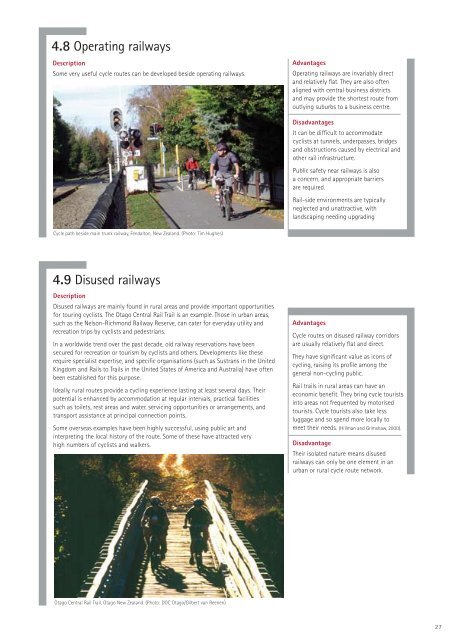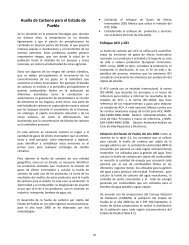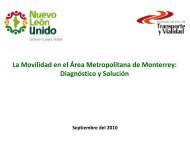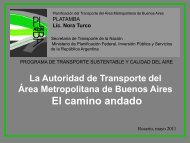CYCLE NETWORK AND ROUTE PLANNING GUIDE
CYCLE NETWORK AND ROUTE PLANNING GUIDE
CYCLE NETWORK AND ROUTE PLANNING GUIDE
You also want an ePaper? Increase the reach of your titles
YUMPU automatically turns print PDFs into web optimized ePapers that Google loves.
4.8 Operating railwaysDescriptionSome very useful cycle routes can be developed beside operating railways.AdvantagesOperating railways are invariably directand relatively flat. They are also oftenaligned with central business districtsand may provide the shortest route fromoutlying suburbs to a business centre.DisadvantagesIt can be difficult to accommodatecyclists at tunnels, underpasses, bridgesand obstructions caused by electrical andother rail infrastructure.Public safety near railways is alsoa concern, and appropriate barriersare required.Rail-side environments are typicallyneglected and unattractive, withlandscaping needing upgradingCycle path beside main trunk railway, Fendalton, New Zealand. (Photo: Tim Hughes)4.9 Disused railwaysDescriptionDisused railways are mainly found in rural areas and provide important opportunitiesfor touring cyclists. The Otago Central Rail Trail is an example. Those in urban areas,such as the Nelson-Richmond Railway Reserve, can cater for everyday utility andrecreation trips by cyclists and pedestrians.In a worldwide trend over the past decade, old railway reservations have beensecured for recreation or tourism by cyclists and others. Developments like theserequire specialist expertise, and specific organisations (such as Sustrans in the UnitedKingdom and Rails to Trails in the United States of America and Australia) have oftenbeen established for this purpose.Ideally, rural routes provide a cycling experience lasting at least several days. Theirpotential is enhanced by accommodation at regular intervals, practical facilitiessuch as toilets, rest areas and water, servicing opportunities or arrangements, andtransport assistance at principal connection points.Some overseas examples have been highly successful, using public art andinterpreting the local history of the route. Some of these have attracted veryhigh numbers of cyclists and walkers.AdvantagesCycle routes on disused railway corridorsare usually relatively flat and direct.They have significant value as icons ofcycling, raising its profile among thegeneral non-cycling public.Rail trails in rural areas can have aneconomic benefit. They bring cycle touristsinto areas not frequented by motorisedtourists. Cycle tourists also take lessluggage and so spend more locally tomeet their needs. (Hillman and Grimshaw, 2000).DisadvantageTheir isolated nature means disusedrailways can only be one element in anurban or rural cycle route network.Otago Central Rail Trail, Otago New Zealand. (Photo: DOC Otago/Gilbert van Reenen)27
















